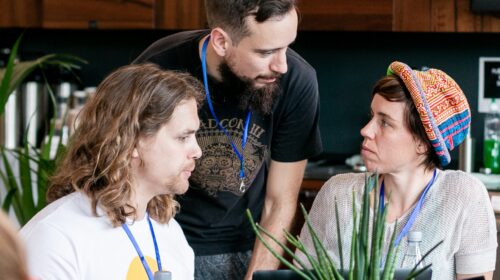
March 6, 2017
6 Tips On Community Building For Early-Stage Startups
Depending on your business, forming a strong community as an early-stage startup can lead to advantages like instilling a sense of loyalty and belonging among users, creating a key point of differentiation for your startup or providing a way to harness direct feedback for product development.
Of course, it’s not without challenges. Especially when trying to get your startup off the ground, building a thriving community requires a lot of hard work and persistence. One of the most important things to figure out off the bat is why you want to build a community and how it will tie into your startup’s vision.
Be honest with your community from the very beginning.
There’s a reason you hear certain things over and over again – because often there’s a truth to them. This goes with our first point. “If you’re genuine with people, they see you as a human being and the relationships that you create through that can be so strong,” said Anaïs Bourg, Community Manager (Europe) at Udacity, a web-based learning platform offering courses mostly in the realm of tech with around 5 million users worldwide. “I think that’s the basis of scaling any kind of community.”
Sharing a similar sentiment is Olof Ekman, Head of Community Management at jovoto, a digital workspace for creatives worldwide. For jovoto, which counts about 85,000 designers and creators in its community, users are a vital component of the platform because they help solve design challenges for clients such as WIRED, Adidas, Greenpeace and Coke among others. Ultimately, the mission is to enable members of the community to lead the kind of independent design careers they want for themselves.
“It’s important to be as transparent as possible about what you are doing, why you are doing it and what you expect to get out of it,” explained Ekman, “It’s hard enough to gain anyone’s trust once and if you misuse this trust or your users think you’re hiding something it’s going to be pretty impossible to gain their trust a second time. On Day 1, be completely open and honest.”
“For young startups, the best way to differentiate from competitors is to build loyalty that is stronger.”
Clearly communicate the value of being part of the community.
Since jovoto’s concept was fairly new when it started, one of the challenges for the company early on was explaining the gist of the platform to its target audience and communicating its value proposition to users. For entrepreneurs starting out, it’s crucial to nail this aspect down if you want to see your community to grow. Users need to understand what you’re doing, why it’s different and how it it’s beneficial to them to join your community.
“Talk to people and figure out what their issues are. Figure out how to make the community as valuable to the users as possible. Provide something they really need,” said Ekman, “The more valuable you are, the more people will join and think the community is worth their time.”
Create a unique community culture.
At Udacity, Bourg says that if there’s one thing that ties the community together, it’s the passion for education. Udacity’s community consists of students who take courses as well as mentors who support students in their learning and offer feedback on progress (who are not course-creators). There’s a lot of engagement between students and mentors, but also among students themselves in terms of encouraging and supporting one another. This sense of helping each other out has become part of Udacity’s community culture.
“For young startups, the best way to differentiate from competitors is to build loyalty that is stronger,” said Bourg, “If you build a really strong community, it’s a factor for growth because you can tap into your community to build case studies and testimonials. By building these relationships, you also build natural brand advocates.”
Similarly, Ekman said that one of the most important things a startup should do at the start is to establish a culture for the community. If the founders don’t set a culture, someone else might do this for you – and this might not be what you intended. “Think about how you want people in your community to interact with each other and how you can support these behaviors,” he added, “The culture that you want, you have to make sure to set an example of it and incentivize certain behaviors.”
Don’t try to control the brand too much.
Sometimes, there’s a tendency for startups to talk at users purely with carefully calculated brand talk in an attempt to protect marketing messages. While there’s a case for sticking to brand/marketing guidelines, it can also go too far and alienate users.
“The best way to make sure that you take your product and brand in the right direction is to let your users in,” said Bourg, “Allow them to give you pointers and don’t be afraid to let them show you the right direction.”
So instead of talking at your users, talk to them. Remind yourself of the importance of being authentic (see point #1) and leaving room for things to organically develop.
“One of the most important things a startup should do at the start is to establish a culture for the community.”
Ask users for feedback.
A good way to gauge how your community is doing and to learn more about the user experience is to call on them for feedback. “Since people in your community are usually the ones that use your products and services most, if you have close relationships with them you can ask them directly about what they think,” explained Ekman, “Instead of a lot of guessing, you’ll have a deeper understanding of how to build a better product. Then, it becomes a lot easier to build something that is actually valuable for people who are using it most.”
Bourg expresses a similar sentiment and said: “Generally, people want to give feedback and be involved as much as possible – don’t just ask them questions or for feedback, but ask them for ideas.”
Empower users to connect with and support each other.
Just because you have a high user count or a lot of social media followers, it doesn’t mean your community is active or engaged. One way to create a community with an edge is to empower community members to talk to each other and support one another.
“Depending on what kind of product you have, think about places in which you can connect to your users,” said Bourg, “It can be offline places, like meetups and events, or it can also be online places, like a Facebook group or a Slack team. If you empower people in your community to help each other out, the community will grow itself and people will find this very rewarding.”

